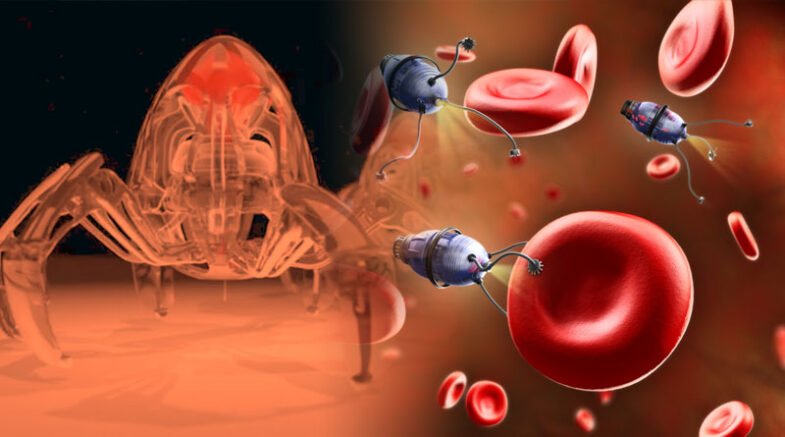tracking of the nanobots inside the body, making it advantageous in targeted drug delivery and personalized medicines.

Miniaturization of robots to nanoscale or nanobots is the idea presented by Richard, who firstly thought about swallowing the doctor in the 1950s. It was also the main idea of a movie came in 1966 in which the crew members of a ship were diminished to very small scale, so they can enter into the body of a person having a blood clot.
At that time it looked like a daydream but with the development in the fields of engineering, nanotechnology, biotechnology and biomaterials, this dream is actually coming true.
Many robots have been made at small scale. Nano-robots also known as nanobots are the one having size in nanoscale (1 to 100 nanometers). These nanoscale devices are destined to perform many different tasks like to manipulate, sense, signal and process information.
The energy for movement of nanobots inside the body can be driven by chemical, physical or biohybrid systems. The chemical nanobots convert the energy of chemicals inside the body into movement while physical nanobots obtain energy from external source such as light waves, ultrasound waves and magnetic field. In biohybrid nanobots, motile microorganism are used as source of locomotion.
Another feature of utmost importance in medical research is localization, which enables tracking of the nanobots inside the body, making it advantageous in targeted drug delivery and personalized medicines.
Nanobots can be used inside the body for number of biomedical application mainly because they are biocompatible. They can cross the blood-brain barrier, which is the main difficulty when using the traditional neuropharmaceuticals and thus can be used to treat neurological diseases and brain tumor by targeted drug delivery.
Nanobots can be used to assist in minimally invasive surgery as they can penetrate deep into the tissues under controlled regulation and tracking. A computational model of a nanobot have also been suggested that can be proven fruitful in treating diabetes and can be practically applied in the in vivo testing.
Most of these applications are tested on animal models such as rats, pigs and mice which have shown that still there are gaps that are needed to be filled in propulsion, localization and design of nanobots that would be suitable for use in human models.
When seen in Pakistan, the cancer charts in top 5 most prevalent disease in Pakistan. Nanobots are programmed that are able to identify 12 various types of cancerous cells with surprising selectivity and accuracy.
As a lot of number of blood vessels are formed round a cancer cell, these nanobots are able to cut off the supply of blood to vessels by the help of coagulation factor, thus causing the shrinkage of tumor cell leading toward tissue death. The use of nanobots will overcome the limitation of chemo and radiotherapy.
For purpose of targeted drug delivery a special payloads are present on their surface that are able to recognize a protein nucleolin that is present in high amount on tumor cells not on normal cells thus play a role like Notorious Trojan horse by control releasing of its drug cargo in fighting against the cancer enemies.
These successful trails are being done on mammals for lungs, breast, ovarian, and melanoma cancer. But nanotechnology is still in its initial phases of development in Pakistan due to lack of research resources and institutes offering it.
